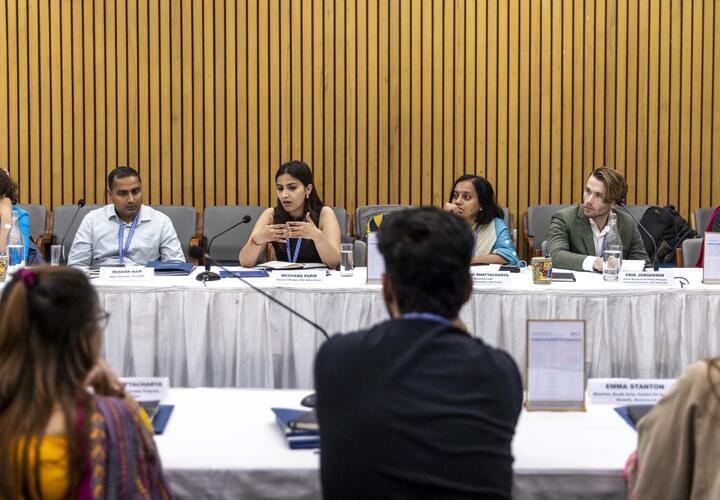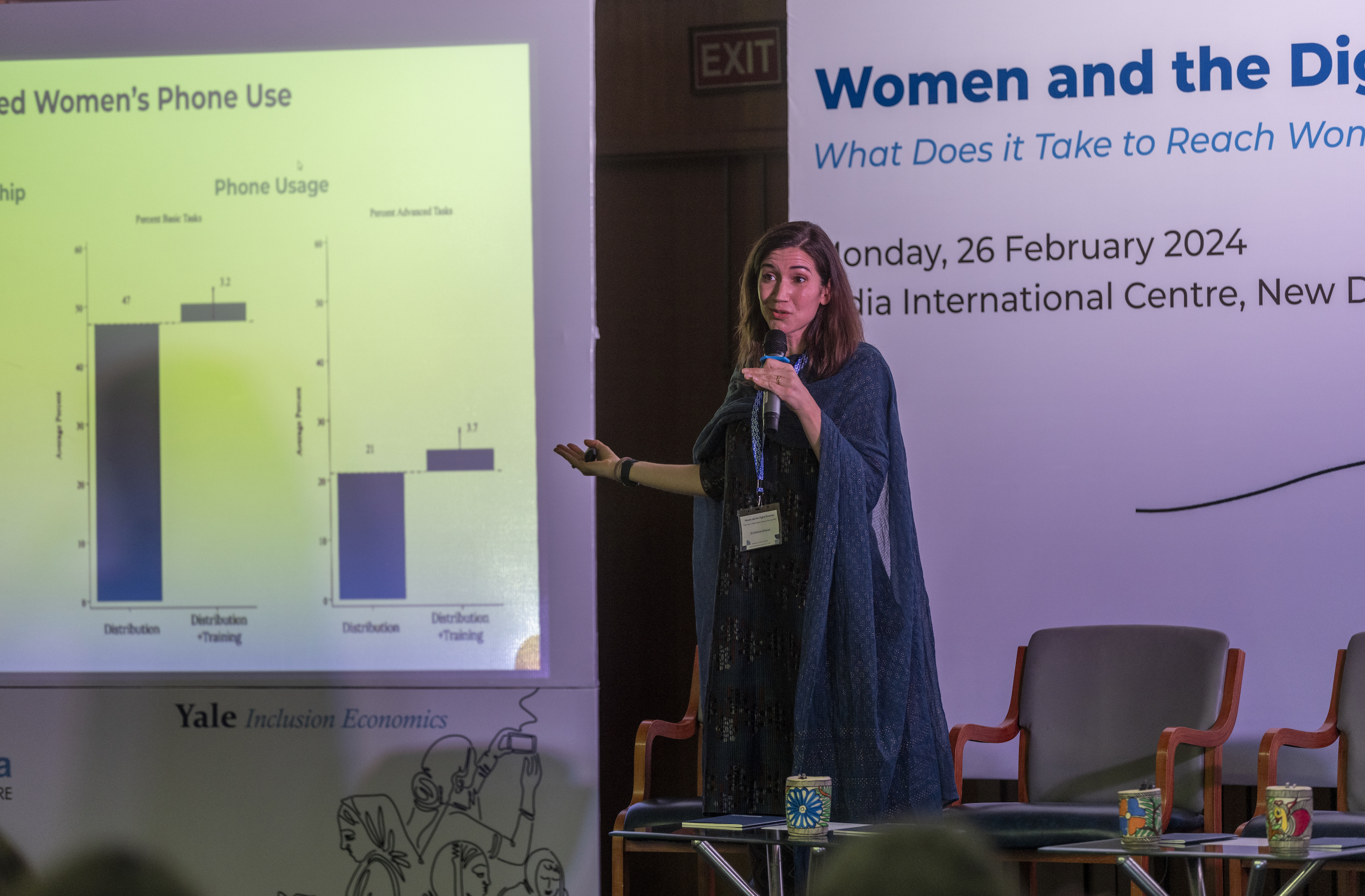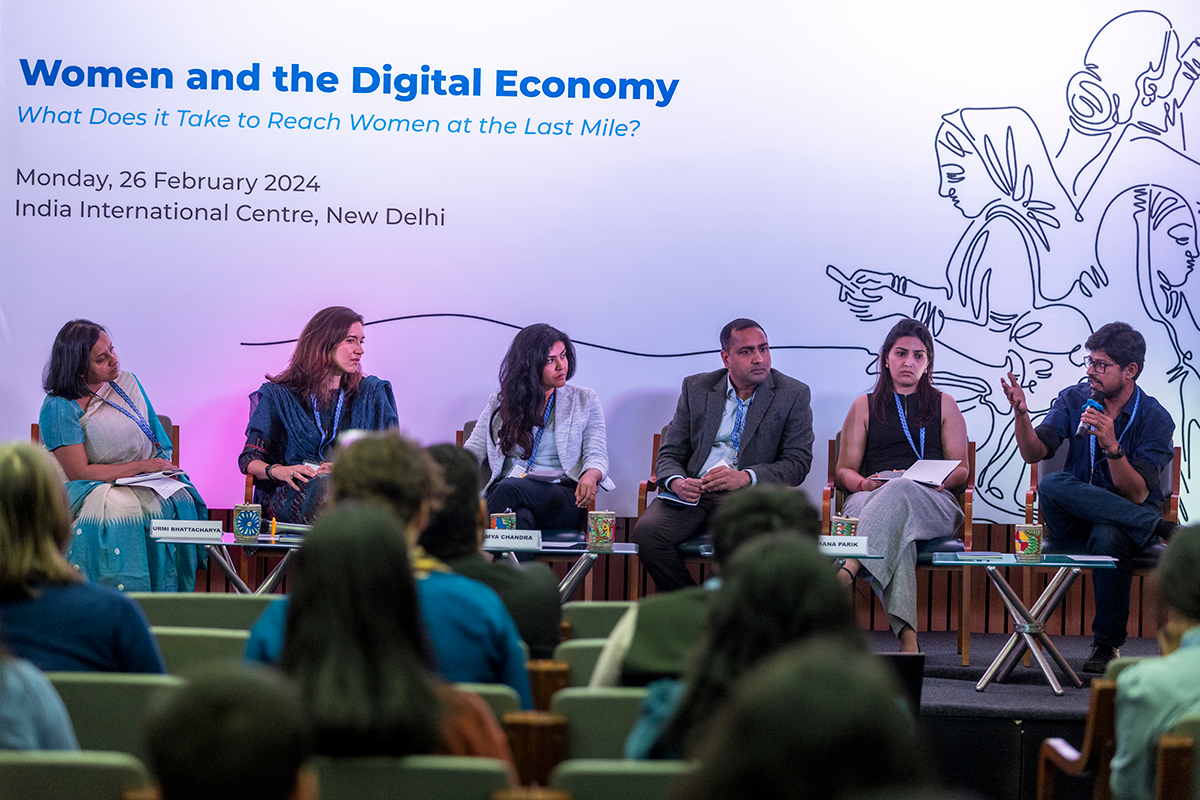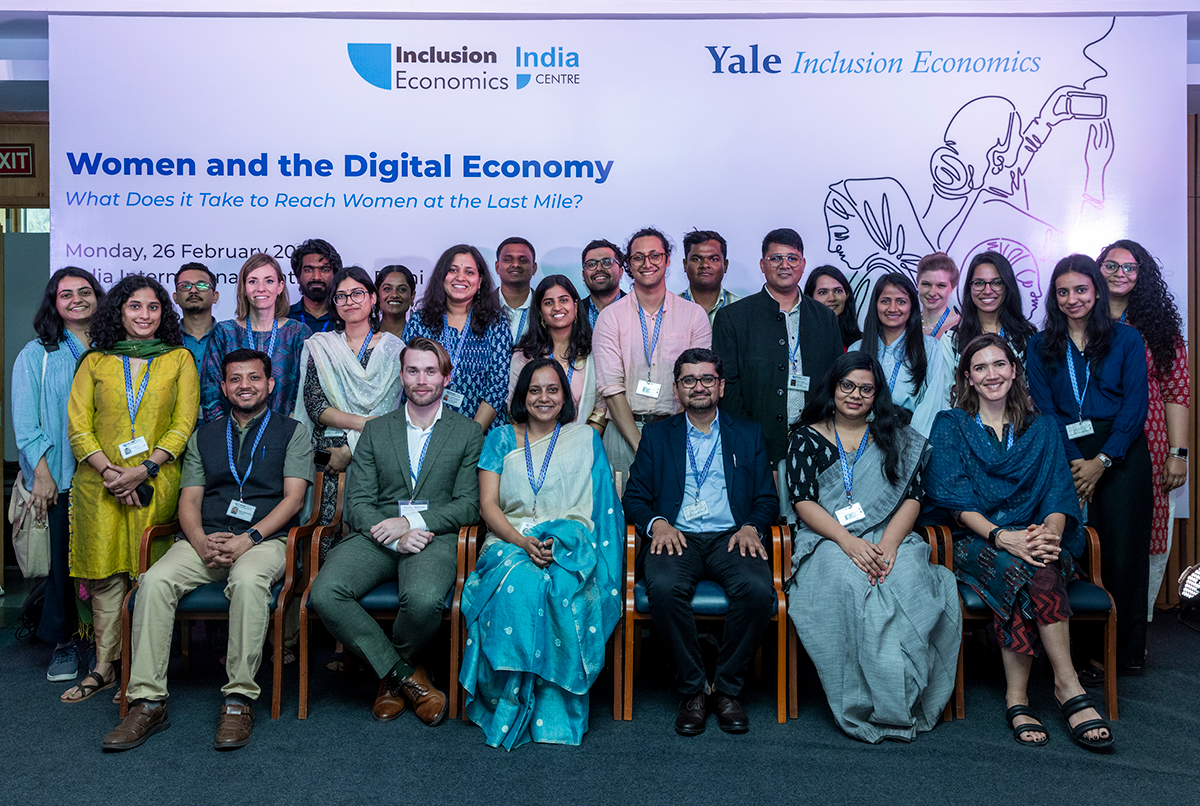Looking back on the "Women and the Digital Economy" event
A key priority for policymakers, researchers, and the larger development community in India is to close the digital gender divide and identify investments to bridge other gender gaps in access and opportunity. On February 26, 2024, Inclusion Economics India Centre and Yale Inclusion Economics convened nearly 70 members of government, academia, philanthropy, and private sector organizations in Delhi, India, to assess available evidence on women and the digital economy.

by Ayushi Khare
For the past decade, the Inclusion Economics India Centre (IEIC) and Inclusion Economics at Yale University (YIE) have conducted rigorous research to address the multifaceted challenges Indian women face, ranging from lack of job opportunities in rural areas to women’s limited digital and financial inclusion. In that time, India has made impressive progress in improving women’s opportunities along many fronts. For example, it has entirely closed its gender gap in bank account ownership, with over 282 million women now owning their own bank accounts. Nearly all women have digital IDs, and increasingly, women are gaining access to mobile phones, which are important access points for financial tools, information, and connection with others.
Yet despite this progress, significant digital gender gaps persist, and Indian women are still 40% less likely than men to access mobile internet. What can we do to close these gaps? On 26 February 2024, IEIC convened researchers, policymakers, and practitioners to share research on policy levers to bridge India’s digital divide and provide a platform for cross-sectoral leaders and decision-makers to reflect on insights and discuss future research and intervention priority areas to close last-mile gender gaps in digital access.
Session 1 – Mapping Digital Gender Gaps: What Do We Know?
Dr Charity Troyer Moore (Scientific Director of Inclusion Economics) began the day by introducing YIE’s and IEIC’s ongoing research on digital gender gaps. Initiated seven years ago, this research has focussed on understanding critical questions around the digital gender divide, including what gaps exist, why they exist, why they matter, and how they can be closed. At the onset of this research, India had one of the world’s highest gender gaps in mobile ownership. Since 2017, the number of women accessing smartphones has increased, but gender gaps have persisted. Economic barriers – due to women’s more limited access to jobs and resources – as well as normative barriers, including the view that phones are not appropriate for women, are both drivers of this persistent gap. Moore’s presentation delved deeper into some of the restrictive norms that limit women’s access to mobile phones, fuelled by beliefs that phones threaten women’s purity and reputation, and they may distract women from caregiving duties. Moore ended her presentation by inviting the room to interrogate how we conceptualize digital inclusion and reflect on the extent to which individual ownership is required to enable women to engage meaningfully with digital technology.

Charity Troyer Moore presenting during the event.
Session 2 – What Works to Close Digital Gender Gaps and Challenge Restrictive Gender Norms?
Dr Simone Schaner (Scientific Director, Gender of Inclusion Economics) shared findings from Inclusion Economics’ studies assessing the impact of two inter-related interventions aimed at closing digital gender gaps. In 2018, under the Sanchaar Kranti Yojana (SKY) program, the Government of Chhattisgarh distributed free smartphones to over 2 million rural women, providing 1GB of free data for the first six months, while ensuring all program villages had LTE network coverage. The IE research team conducted a quasi-experimental study based on the program eligibility rules to understand the program's impacts. The team also provided group-based digital literacy training to a subset of SKY beneficiaries living in the capital district in a randomized control trial (RCT). Schaner’s presentation outlined a critical emerging insight from these studies. Despite the program being well implemented and initially reversing the gender gap, the longer-run follow-up shows that it did not close gender gaps in ownership and smartphone usage. Drawing on evidence from the complementary RCT, however, the research team found that attending the 45-minute digital training significantly increased women’s smartphone usage (82.3% in the treated group, compared to 77.5% in the control) two years after the training took place. Further, training improved women’s mental health, potentially driven by enhanced social networks facilitated through phones, highlighting the broader value of closing digital gender gaps on other essential aspects of women’s well-being.

Simone Schaner sharing findings from Inclusion Economics' studies.
Alex Paul Menon, the former Chief Executive Officer of the Chhattisgarh Infotech Promotion Society (CHIPS), reflected on his leadership experience driving the SKY program. His talk centred on the underlying motivation for the program and the research partnership and how the local political economy affected the ability to adhere to SKY’s original vision. The program began with the objective of empowering each household with a mobile phone, and then deploying digital tools to help recipients access the state through those new phones, to provide government services digitally at citizens' doorsteps, creating a key access point for the government and a use case for women who had received the phones. Menon noted several challenges during program rollout, which could have impeded the program’s success in keeping phones in the hands of women, and ways they addressed it.
Session 3 – Lightning Innovation Round
Presentation 1: Working Within Norms Constraints to Increase Women’s Phone Use: Mor Awaaz by Inclusion Economics India Centre and Inclusion Economics at Yale University
Dr Charity Troyer Moore (Scientific Director of YIE) returned to share insights from an Inclusion Economics experimental study investigating a program they launched called ‘Mor Awaaz’. Through weekly automated calls, the study focused on providing useful information to women who recently received free smartphones through the SKY program. These entertaining, informational calls covered various topics spanning government benefits to women’s health. In addition to these calls, Mor Awaaz collected information through short phone surveys where women’s opinions and experiences were shared with the government. The Mor Awaaz service effectively disseminated information to these women, who reported sharing it with others. It was valued as an opportunity to share their experiences, but it did not result in greater phone ownership and use when compared to other women who had received SKY phones and training.
Presentation 2: AI for Dignified Livelihoods by Karya Inc
Safiya Husain (Co-Founder, Karya Inc.) introduced Karya’s work, which focuses on providing well-paid, flexible, and remote data work to individuals living in rural India (of which 50% are women) by connecting them to the global Artificial Intelligence (AI) ecosystem. Husain also described Karya’s efforts to couple financial literacy education with the existing speech data generation work to promote skill development in tandem with income generation. Qualitative interviews revealed the popularity of their new story-based tasks curriculum, which facilitated easy learning, sparked community discussions and fostered financial hope and dialogue among family members. Comparing pre- and post-tests from this trial group of participants, they found a large increase in measures of financial literacy.
Presentation 3: “What does digital mean to women in the world of unorganised work?” by Self Employed Women’s Association (SEWA)
Sonal Sharma (Coordinator, SEWA) presented SEWA’s work on providing digital and financial literacy training to women in the informal sector. The presentation focussed on sharing insights from a SEWA study titled “Impact of Access to Smartphones for Women in the Informal Sector”, which studied 90 beneficiaries of a SEWA and USAID collaborative programme titled ‘Udyami’, wherein beneficiaries were provided with smartphones to contribute to their holistic development as grassroots micro-entrepreneurs, business owners and women in the informal economy. These women were based in Punjab, Rajasthan, Bihar, Jharkhand, West Bengal, and Nagaland. Drawing on their study, Sharma shared that only 2% of women were using 15 or more applications, while 41% used less than 10 applications on their smartphones, and the majority of women fell somewhere in between (10-14 applications). Sharma further shared that SEWA’s recent approach to digital inclusion has four priorities: leveraging digital technology to boost livelihoods, accessing social security provisions, increasing the efficiency of routine operations and raising awareness and outreach for online selling.
Presentation 4: Gender Norms in Mobile Phone Ownership & Usage in India by BBC Media Action
Meghana Parik (Research Manager, BBC Media Action) shared the results of BBC Media Action’s immersive primary research activities across nine cities in India. Compared to young men, young women’s phone use was much more closely restricted and monitored, with females reporting 42 percentage points higher levels of phone-related supervision. The research identified high adherence to gender-based expected roles and responsibilities and limited voice and agency for women and girls. Sexuality and marriage norms underpin all areas of girls and women’s lives and contribute to women’s vulnerability online. Some emergent themes to inform their ongoing work include distinguishing between protection and control, focusing on the transition to adulthood, and gender socialization, which also underline the observations around the interplay between digital gender gaps and norms. As a next step, the research team is exploring to identify enablers and barriers to digital use. This will feed into plans to develop pathways to change and operationalize gender-equal digital outcomes in India.
Session 4 – Panel Discussion: Policy and Practitioner Perspectives on Closing Digital Gender Gaps
Kamya Chandra (Chief Strategy Officer, Center for Digital Public Infrastructure), Roshan Nair (Digital Specialist, Development Innovation Ventures-United States Agency for International Development), Meghana Parik (Research Manager, BBC Media Action) and Arjun Venkatraman (Program Officer (Digital), Bill & Melinda Gates Foundation) then joined the stage for a panel moderated by Dr. Urmi Bhattacharya (Research Lead, IEIC). The discussion began by asking what role policy should play in addressing mobile gender gaps. Venkatraman outlined the fundamental need to deconstruct how digital gaps are conceptualized to understand corporate and consumer perspectives better. Chandra suggested that the digital divide is best addressed by focusing on the underlying infrastructure and using this as a platform to aid other policies and projects rather than seeking to close gaps through standalone service interventions. Panelists also reflected on missing elements in ongoing conversations around mainstreaming. Parik emphasized the need to update the law to reflect the digital environment. Despite technology-enabled sexual and gender-based violence being a prevalent concern for women in the digital space, there is currently a lack of legislation promoting protection. Nair added to this discussion by asking us to step back and think about digital inclusion for women extending beyond phone ownership and ensuring that women can participate in the underlying tech and infrastructure development.

Panel discussion moderated by Urmi Bhattacharya, featuring Simone Schaner, Kamya Chandra, Roshan Nair, Meghana Parik, and Arjun Venkatraman.
Hoping to continue building on the momentum from this event, Vinay Nagaraju, the Executive Director of IEIC, shared that the Inclusion Economics team will focus on ways to collaborate with individuals and organizations with this shared vision and work towards finding research-backed recommendations to encourage women’s mobile access in the Indian landscape.

Group photo of event co-organizers.
YIE would like to acknowledge input from Urmi Bhattacharya, Ayush Jain, Erik Jorgensen, Charity Troyer Moore, Vestal McIntyre and Vinay Nagaraju to this article.